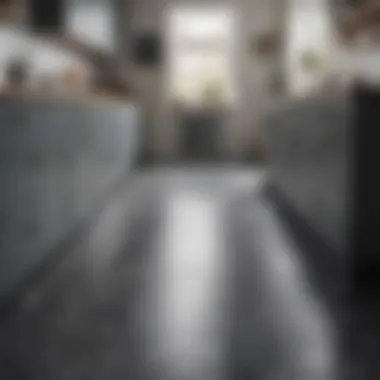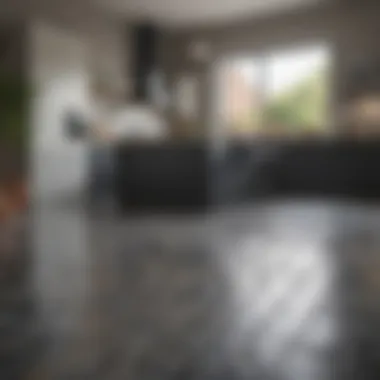Comprehensive Guide to Anti-Slip Kitchen Flooring


Intro
When it comes to creating a safe and stylish kitchen, the flooring you choose plays a crucial role. Anti-slip kitchen flooring not only enhances the aesthetic of the space but also significantly reduces the risk of accidents. This guide explores various materials, designs, installation considerations, and maintenance practices related to anti-slip flooring.
Understanding the importance of anti-slip surfaces becomes even more relevant when considering that kitchens are often prone to spills and wetness, making the choice of flooring a vital aspect of kitchen safety. Homeowners and interior design enthusiasts alike will benefit from exploring the numerous options available.
Design Inspiration
Finding the perfect balance between aesthetics and functionality is key when selecting anti-slip flooring. Here, we discuss some current trends in kitchen design and relevant color schemes that enhance your space while providing safety features.
Current Trends in Interior Design
- Natural Materials: Organic materials like wood and stone are popular for their timeless appeal while still integrating anti-slip properties.
- Large Format Tiles: These create an illusion of a larger space and are available in various finishes, including matte options that provide grip.
- Sustainable Choices: Many modern homeowners prefer eco-friendly materials that do not compromise on safety or style.
When selecting flooring, consider how these trends impact your kitchen’s overall design narrative. This approach results in a cohesive look that adds both value and safety to your home.
Color Schemes and Palette Ideas
The color of your kitchen flooring can have a significant impact on the room's ambiance. Here are some ideas:
- Neutral Tones: Shades like beige, gray, or taupe can provide a calm and spacious feel, making them perfect for busy kitchens.
- Bold Hues: Bright colors add vibrancy and energy. Consider tiles with anti-slip finishes in colors like navy blue or deep green.
- Patterns and Textures: Incorporating patterned tiles can break up monotony. Look for textured options that diffuse light, thus minimizing visible dirt and wear.
Choosing the right color scheme combined with anti-slip characteristics creates an appealing and secure kitchen environment.
"Anti-slip flooring is not merely a safety feature; it enhances the beauty of a well-designed kitchen."
By prioritizing both safety and aesthetics, homeowners can elevate their kitchen space to one that is not only visually striking but also functional for everyday use.
Epilogue
The journey to selecting anti-slip kitchen flooring is one that blends safety with design considerations. By exploring current trends and color schemes, homeowners can create a stylish and practical kitchen. This guide serves as a foundation for making informed decisions, ultimately enhancing both the allure and functionality of kitchen spaces.
Prelims to Anti-Slip Kitchen Flooring
In today's kitchen design, safety has surfaced as a primary concern. Anti-slip kitchen flooring offers a compelling solution to a common issue: slips and falls in the kitchen. As the hub of numerous activities, kitchens often experience spills, dropping food, and wet surfaces. Therefore, understanding the role of anti-slip flooring is essential for creating both a safe and inviting environment.
The importance of anti-slip flooring cannot be overstated. Besides protecting against accidents, it also contributes to the overall aesthetic and functionality of the space. Homeowners are increasingly prioritizing materials that not only look beautiful but also ensure safety for their families and guests. This guide aims to provide clarity on various options available in the realm of anti-slip flooring, considering factors like style, maintenance, and installation.
By prioritizing anti-slip flooring, one can effectively minimize risks associated with kitchen activities. Selecting appropriate materials can turn a kitchen from merely functional to a stylish space that harmonizes safety with design. Here, we will explore the implications of choosing these materials, helping you to navigate the industry with informed choices.
Whether you are a homeowner revamping your cooking area or an interior design enthusiast seeking current trends, understanding the benefits of anti-slip flooring will equip you with the knowledge necessary to make quality decisions. This discussion extends beyond mere aesthetics; it caters to both safety and practicality in modern kitchens. For those hosting gatherings or simply engaging in day-to-day activities, anti-slip floors are a significant aspect to consider.
Importance of Anti-Slip Flooring in Kitchens
Anti-slip flooring in kitchens goes beyond just aesthetics. It plays a vital role in enhancing safety and functionality. As kitchens are often places of high activity, the necessity of flooring that minimizes the risk of slips and falls cannot be overstated. Such flooring solutions offer comfort and stability, which is especially important for households with children or elderly individuals.
In a culinary environment, water spills, oil splatters, and food debris are common occurrences. These factors contribute significantly to slippery conditions. Therefore, anti-slip flooring provides crucial traction, effectively reducing the chances of accidents.
Moreover, the implementation of anti-slip surfaces can reassure homeowners and occupants. A safe kitchen promotes peace of mind, allowing individuals to focus on cooking and family interaction instead of worrying about potential hazards.
In addition to safety, anti-slip flooring materials often come in diverse designs that appeal to many styles. These options allow homeowners to select materials that not only protect but also elevate the visual aspect of the kitchen. A well-designed flooring option can enhance the overall look and feel of the space, merging functionality with style.
"Choosing the right flooring is a blend of safety and design. Anti-slip options are not only practical but can also be visually appealing."
Lastly, it is essential to consider the legal and regulatory factors related to flooring installation in kitchens. Many regions have specific building codes that require anti-slip surfaces in high-risk areas. Adhering to these regulations ensures compliance and enhances safety for all kitchen users. The importance of anti-slip flooring is evident, weaving together aspects of safety, aesthetics, and legality, making it a crucial consideration for any kitchen design.
Types of Anti-Slip Flooring Materials


In the context of kitchen design, choosing the right anti-slip flooring material is essential. These materials contribute significantly to safety, which is crucial for preventing slips and falls. Beyond safety, materials also influence the overall aesthetic and functionality of the kitchen. Selecting the right type can help create a harmonious environment while ensuring durability and ease of maintenance. Below, we will explore various materials commonly used for anti-slip flooring in kitchens, outlining key attributes, benefits, and considerations.
Vinyl Flooring
Vinyl flooring has grown in popularity in recent years due to its versatility and budget-friendliness. This material comes in various patterns and colors, mimicking more expensive options like hardwood or stone.
One advantage is its slip-resistant properties, which can be enhanced with specific textures or finishes. Vinyl is also waterproof, making it ideal for a kitchen environment where spills are common. Maintenance is straightforward, as regular sweeping and mopping are sufficient to keep it looking new.
For homeowners on a tight budget, vinyl presents an appealing option without sacrificing safety or style.
Ceramic Tiles
Ceramic tiles are another excellent choice for anti-slip kitchen flooring. They are available in numerous designs, allowing for creative expression in kitchen aesthetics. Certain types of glazed ceramic tiles offer a higher slip resistance compared to others.
The hardness of ceramic tiles provides durability, making them resistant to scratches and stains. They are also easy to clean, which is crucial in a high-traffic area like the kitchen. However, ceramic tiles are somewhat cold underfoot, which might be an essential consideration during colder months.
Natural Stone
Natural stone flooring, such as slate or limestone, not only adds elegance to a kitchen but also possesses inherent anti-slip qualities. The texture of these materials creates traction, reducing the likelihood of slipping.
Natural stone can be more expensive and often requires more maintenance than other options, including sealing to prevent stains and moisture penetration. However, many find the visual appeal and unique characteristics worth the investment.
Laminate Flooring
Laminate flooring offers the aesthetic appeal of wood or stone at a reduced cost. While typically not as slip-resistant as other materials, several laminate options come with a textured surface designed to enhance grip.
Its installation is usually easier, which may appeal to DIY enthusiasts. Cleaning laminate floors is generally easy, as they can be wiped down with a damp cloth. Still, it is crucial to ensure the chosen laminate is suitable for kitchen use, as they can be prone to water damage if not properly sealed.
Rubber Flooring
Rubber flooring is one of the most pragmatic choices for kitchens, particularly in spaces subjected to heavy use, such as commercial environments. This material provides excellent slip resistance and is soft underfoot, reducing fatigue for those who spend long hours in the kitchen.
In addition, rubber is known for its durability and shock absorption. It comes in various colors and patterns, allowing for customization in design. Cleaning rubber flooring is effortless; however, it may show marks and require periodic deep cleaning to maintain its appearance.
Each flooring type has its pros and cons, so it's essential to weigh these according to specific kitchen needs and personal preferences.
Design Options for Anti-Slip Floors
Selecting the right design options for anti-slip flooring goes beyond mere aesthetics. It is crucial for both function and style in a kitchen environment. This section will examine various aspects of design that homeowners should consider when opting for anti-slip flooring. The choices in color, finish, patterns, and textures can significantly influence not only the practicality but also the overall atmosphere of the kitchen. By understanding these elements, one can create a kitchen that is both safe and visually appealing.
Color and Finish Preferences
Color plays a pivotal role in setting the mood of a kitchen. When choosing anti-slip flooring, one should consider lighter shades to amplify natural light, making the space feel larger and more inviting. Neutral tones can offer versatility while allowing you to blend or contrast with cabinetry and countertops.
In terms of finish, it is essential to consider the sheen of the flooring. Matte finishes often offer better slip resistance compared to glossy options, which can become slippery when wet. However, this does not mean that one should completely shy away from shiny surfaces. Certain treatments and coatings can enhance the slip resistance of glossy finishes.
When making decisions about color and finish, it is advisable to focus on:
- Durability: Some colors may fade faster than others. Consider materials that hold their color over time.
- Complementary Elements: Ensure that the flooring color enhances other kitchen components like cabinets and walls.
- Trends vs. Timelessness: While it can be tempting to follow the latest trends, also consider whether the color will stand the test of time.
"A well-chosen color palette can not only enhance the safety aspect of a kitchen but also make it a welcoming space for family and friends."
Patterns and Textures
Incorporating patterns and textures into anti-slip flooring can elevate the overall design of your kitchen. Patterns can act as focal points, drawing attention in a stylish yet subtle manner. For instance, tile arrangements in varied patterns can create visual interest without compromising safety.
Textures are another important factor. Textured flooring is more effective at preventing slips compared to smooth variations. Many materials, such as ceramic and rubber, come with textures that enhance grip while also providing an appealing look.
When considering patterns and textures, pay attention to:


- Size and Scale: The size of the pattern should fit the kitchen's dimensions. Larger patterns may overwhelm a small space, while smaller patterns might get lost in a larger area.
- Coherence: Ensure that the chosen pattern complements other design elements in the kitchen.
- Maintenance: Some patterns may require more upkeep than others, with grooves or textures trapping dirt.
Ultimately, a well-thought-out approach to design options for anti-slip floors can enhance both the safety and beauty of a kitchen, marrying form and function seamlessly.
Installation Considerations
The process of installing anti-slip kitchen flooring involves several key components that can significantly influence both safety and functionality. Effective installation is crucial to ensure that the flooring remains durable and maintains its anti-slip properties over time. This section will delve into some important installation considerations, providing insights into DIY versus professional installation, subfloor preparation, and the proper use of adhesives and sealants.
DIY vs Professional Installation
When it comes to installing anti-slip kitchen flooring, one of the first decisions a homeowner must make is whether to undertake the project themselves or hire a professional.
Advantages of DIY:
- Cost Savings: Choosing a DIY route can save money, as labor costs are eliminated.
- Personal Control: Homeowners can work at their own pace and make real-time decisions based on personal preference.
- Learning Experience: Completing a flooring project can provide valuable skills and a sense of accomplishment.
Challenges of DIY:
- Time-Consuming: It may take significantly longer to complete the project compared to professionals who have experience.
- Skill Level: Not everyone has the technical skills required for flooring installation, which can lead to mistakes.
- Setup and Tools: Ensuring all necessary tools and materials are ready can be a logistical challenge.
In contrast, professional installation provides the benefit of expertise. Professionals know how to assess the subfloor, select suitable materials, and ensure that the installation meets safety standards. People who choose professional help can have confidence in the durability and safety of their new flooring.
Subfloor Preparation
Subfloor preparation is a critical step in the flooring installation process. A well-prepared subfloor ensures a stable base, which is essential for any floor type. Without proper preparation, the flooring can warp, crack, or lose its anti-slip effectiveness over time.
The following steps outline effective practices for subfloor preparation:
- Inspection: Examine the subfloor for any signs of damage, mold, or moisture. Any issues should be addressed prior to installation.
- Cleaning: The subfloor must be free from dust, debris, and old adhesive residues. This promotes better adhesion for the new flooring.
- Leveling: Any uneven surfaces should be leveled out using a self-leveling compound. This is especially important for vinyl and tile installations, where unevenness could lead to injury or damage.
Proper subfloor preparation can ultimately prolong the lifespan of the anti-slip flooring and maintain its functionality.
Using Adhesives and Sealants
The selection and application of adhesives and sealants play a significant role in flooring installation. Proper bonding is essential to maintain the integrity of the flooring and its anti-slip characteristics.
Here's an overview of essential points related to adhesives and sealants:
- Types of Adhesives: Different materials require different types of adhesives. For instance, pressure-sensitive adhesives work well with vinyl, whereas natural stone may require a thin-set mortar.
- Application Method: Following the manufacturer's specifications for adhesive application is necessary to ensure optimal performance. Using the correct trowel size or application method will enhance bonding capabilities.
- Sealant Usage: After installation, applying a sealant can provide additional protection against moisture and staining, particularly for porous materials like natural stone. It can also help maintain the anti-slip surface.
Proper application of adhesives and sealants can reduce maintenance issues down the line and contribute to overall kitchen safety.
Effective installation of anti-slip kitchen flooring is a blend of preparation, correct material selection, and technical expertise. Investing time in this phase can yield substantial long-term benefits.
Maintenance of Anti-Slip Flooring
Maintaining anti-slip flooring is crucial for several reasons, primarily focusing on extending its lifespan and preserving its safety features. Regular upkeep ensures that the flooring continues to perform effectively against slips and falls that can occur in a kitchen environment, particularly when water and food splatters are prevalent. A well-maintained floor not only retains its aesthetic appeal but also provides a safe environment for cooks and guests alike. Investing time and effort into the maintenance of anti-slip flooring can yield both immediate and long-term benefits.
Cleaning Techniques
Proper cleaning is essential for keeping anti-slip floors at their best. Here are a few effective techniques that should be incorporated:
- Use mild detergents: Avoid harsh chemicals that can degrade the surface. A gentle soap mixed with warm water can effectively clean most anti-slip materials without causing damage.
- Regular dusting and sweeping: Routine removal of dust and debris prevents scratches and maintains a clean appearance. Use a soft broom or microfiber cloth.
- Mop with care: For deeper cleaning, a damp mop can be employed, ensuring that the mop is not overly wet. Excess moisture can lead to slipping and hinder the anti-slip properties.
- Spot clean spills promptly: Immediate attention to spills helps prevent residues from soaking and hardening, which could compromise safety.
By adopting these cleaning practices, you can significantly enhance the safety and appearance of your anti-slip flooring over time.
Preventing Wear and Tear
To prevent wear and tear on your anti-slip flooring, consider the following actions:


- Apply protective coatings: Depending on the material, adding a protective layer can help shield the surface from daily wear and tear. Periodically renewing this coating can extend the floor's life.
- Use appropriate mats: Placing rubber mats in high-traffic areas can reduce friction damage and absorb impact, sustaining the floor’s texture.
- Avoid dragging heavy items: When moving appliances or furniture, lifting is preferable to dragging, as the latter can scratch and wear down the finish.
- Routine inspections: Regular checks can catch early signs of damage, allowing for timely repairs. Look for loose tiles, cracks, or other irregularities.
Engaging in these protective measures allows homeowners and design enthusiasts to enjoy their kitchen’s anti-slip flooring both safely and stylishly, ensuring lasting performance.
Emerging Trends in Anti-Slip Flooring
The landscape of kitchen flooring is continually changing, influenced by buyer preferences and technological brands. Not only does this evolution cater to style, it also significantly promotes safety through innovative solutions. Emerging trends in anti-slip flooring reflect the balance that homeowners seek between aesthetics and functionality, making them crucial for modern kitchen designs.
Eco-Friendly Options
Sustainability is no longer just a trend—it's a necessity. Eco-friendly anti-slip materials are gaining popularity among conscientious homeowners. These materials, often sourced from renewable resources, minimize the environmental impact characteristic of traditional flooring alternatives.
- Bamboo Flooring: It’s a strong and sustainable choice. Bamboo grows rapidly and can be harvested without destroying the plant itself. Its naturally textured surface provides good anti-slip properties.
- Recycled Materials: Flooring products made from reclaimed wood or recycled rubber can offer designer appeal while promoting sustainability. These materials reduce waste and provide unique character to kitchen spaces.
- Low VOC Finishes: Many new anti-slip coatings have low volatile organic compounds (VOCs). This means safer indoor air quality, making them preferable for home environments, especially in kitchens where cooking occurs.
Using eco-friendly materials can not only enhance your kitchen's look but also ensure a reduced ecological footprint, aligning with the values of the sustainable lifestyle.
Smart Flooring Technologies
As technology progresses, so does its integration into home elements, including flooring. Smart flooring technologies in the anti-slip category enhance usability and safety in kitchens. These advances can provide real-time data and greater interaction.
- Temperature Regulation: Certain smart flooring options can adjust to changes in temperature. This is particularly advantageous in kitchens where heat from cooking can drastically vary temperatures. Smart materials help maintain comfortable surface temperatures.
- Sensors for Slippage: Some innovative products come equipped with sensors that alert users if the surface becomes too wet or slippery, significantly reducing the risk of falls. These technologies allow homeowners to avoid potential hazards even before they occur.
- Integrated Lighting: Floors that integrate lighting can help guide through spaces, particularly at night. Brighten your kitchen and minimize accidents by having well-lit paths made through slip-resistant materials.
Integrating smart flooring technologies is a proactive way to enhance kitchen safety. As the demand for smarter homes grows, so too will the unveiling of more advanced anti-slip flooring options.
"The synergy of technology and safety is at the forefront of modern kitchen design."
In summary, staying informed about the latest trends in anti-slip flooring will not only provide peace of mind concerning safety but also allow homeowners to create kitchens that are both stylish and smart.
Cost Analysis of Anti-Slip Kitchen Flooring
When considering any flooring option for the kitchen, understanding the cost implications is crucial. The investment in anti-slip kitchen flooring can vary based on multiple factors. However, analyzing both the initial cost and potential long-term savings can aid in making an informed choice.
Initially, the choice of material plays a significant role in determining overall expenses. For instance, premium materials like natural stone may require a higher upfront investment compared to vinyl or laminate. While the initial outlay is important, it is critical to consider aspects such as durability, maintenance, and safety benefits that can contribute to cost-effectiveness over time.
Homeowners should also take into account the lifespan of the flooring. Anti-slip tiles, for example, may cost more but can last decades with proper maintenance. This durability can lead to significant savings as it reduces the need for frequent replacements. Furthermore, some materials offer better resistance to wear and tear, ultimately lowering the frequency of repairs.
Initial Investment Versus Long-Term Savings
The assessment of initial investment against long-term savings often reflects a practical approach in flooring decisions.
- Material Assessment:
- Maintenance Costs:
- Safety:
- Vinyl flooring can often be installed at lower costs. However, it might wear quicker than ceramic tiles, requiring earlier replacement. For homeowners who prefer budget-friendly options, vinyl presents an attractive initial cost.
- On the other hand, natural stone flooring, while requiring a higher investment, can last substantially longer and demand less maintenance. It may be considered a more effective long-term investment despite higher upfront costs.
- Certain types of flooring require specific cleaning products and more frequent maintenance cycles. Evaluating the cost of these maintenance requirements plays an essential role in budget planning.
- Anti-slip materials, if selected wisely, can minimize accidents in the kitchen, which can be cost-effective in preventing injuries and associated medical expenses.
- Investing in anti-slip flooring may seem costly at first but paying attention to safety can prevent accidents. A safe kitchen environment is invaluable and can enhance the overall quality of life.
"Selecting the right flooring impacts not just the budget, but also the safety and functionality of the kitchen space." – Expert Interior Designer
In summary, while the initial cost of anti-slip kitchen flooring can vary, it is essential to weigh this against long-term savings. The right choice will reflect both budget-friendly choices and the inherent value in safety and durability.
Ending
The conclusion serves as a critical element of any comprehensive guide, particularly in the context of anti-slip kitchen flooring. It is not merely a summary of points previously discussed; rather, it synthesizes the insights gained throughout the article into a cohesive understanding. In kitchens, where safety is paramount, choosing the right flooring material is essential. It not only prevents slips and falls but also enhances the overall aesthetics of the space.
Homeowners should consider various aspects during their decision-making process. These include the type of materials available, the design options that align with personal style, and the long-term benefits of investing in anti-slip flooring. Potential buyers need to recognize that while initial costs may be higher for certain materials like ceramic tiles or natural stone, the durability and safety they offer can lead to significant savings over time.
Additionally, this guide emphasizes the importance of maintenance. Proper cleaning techniques and preventive measures against wear and tear can greatly extend the lifespan of anti-slip flooring. Therefore, understanding how to care for these materials is essential for homeowners aiming to maintain both functionality and aesthetics.
"Choosing the right anti-slip kitchen flooring is an investment in safety and style."
Emerging trends, such as eco-friendly materials and smart technologies, further highlight the evolving nature of kitchen flooring. As more homeowners become aware of their choices, the demand for innovative solutions will likely increase.
In essence, this guide aims to equip readers with the knowledge to make informed decisions, ensuring their kitchens are not only safe but also a reflection of their unique tastes. From installation to maintenance, every aspect contributes to creating a stylish and secure kitchen environment, urging readers to prioritize anti-slip flooring as crucial in their home enhancement journey.



